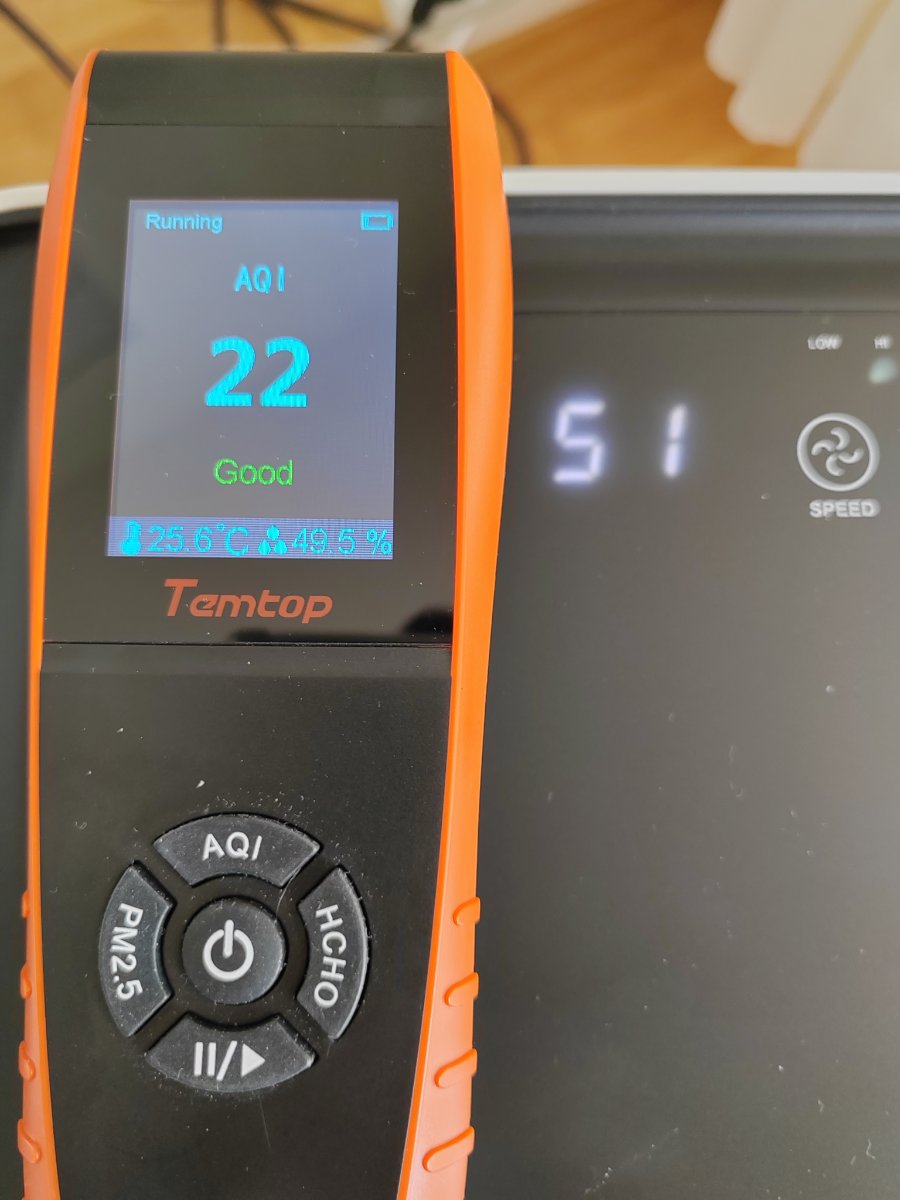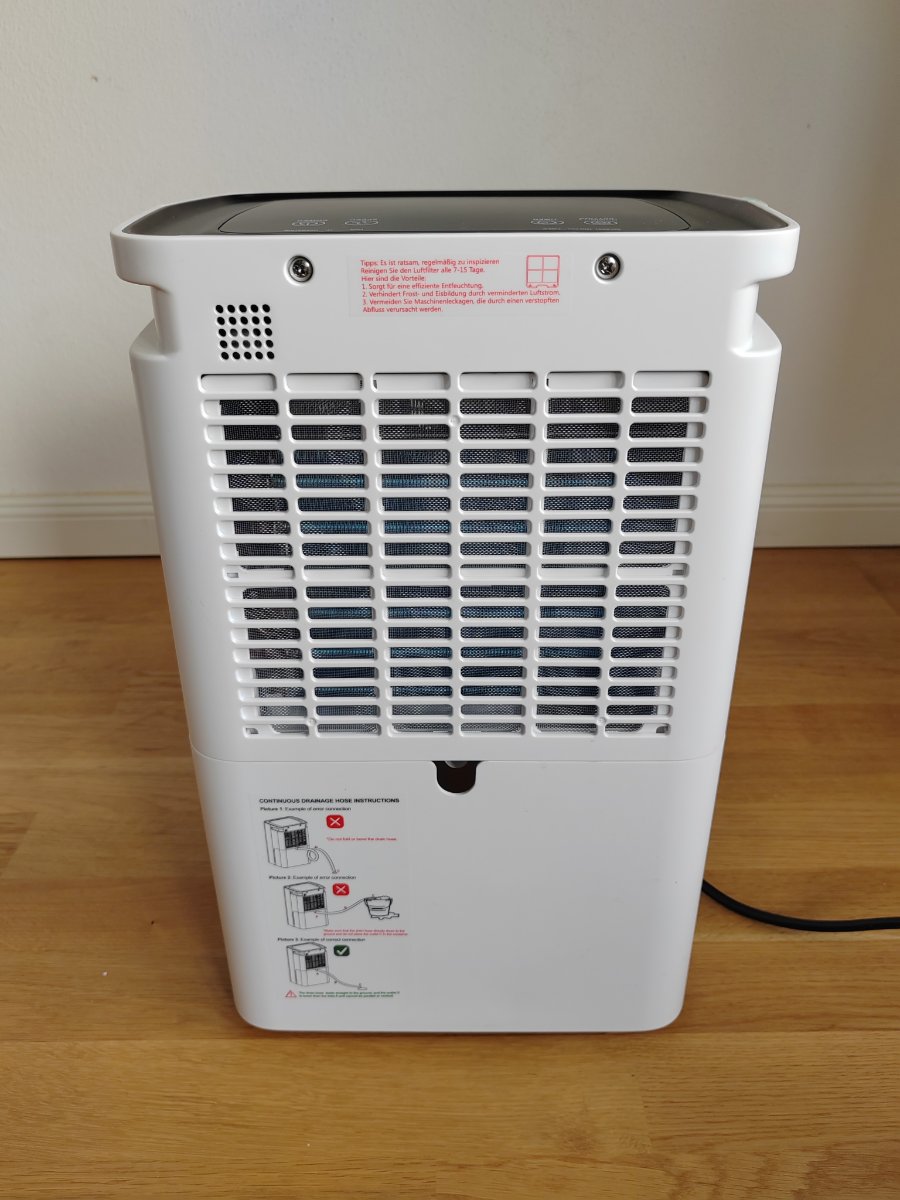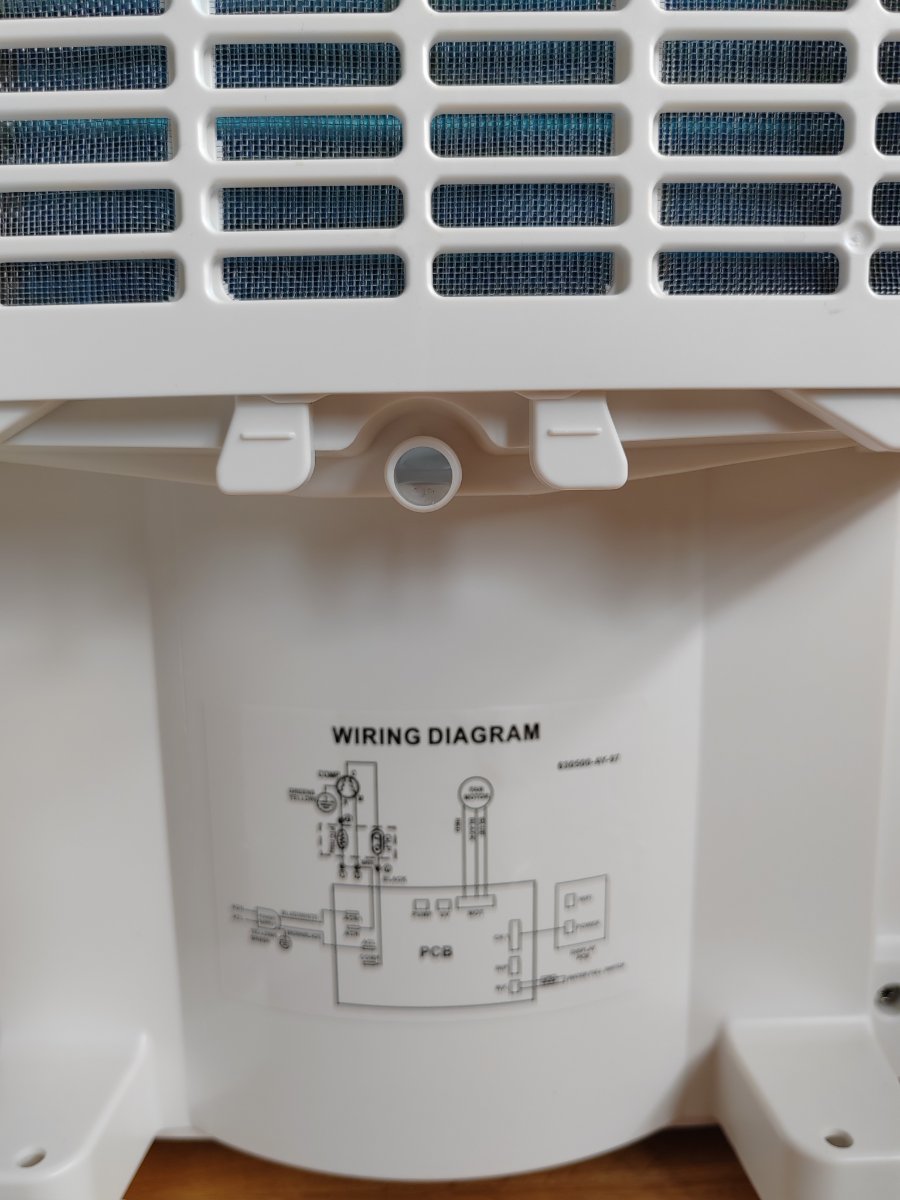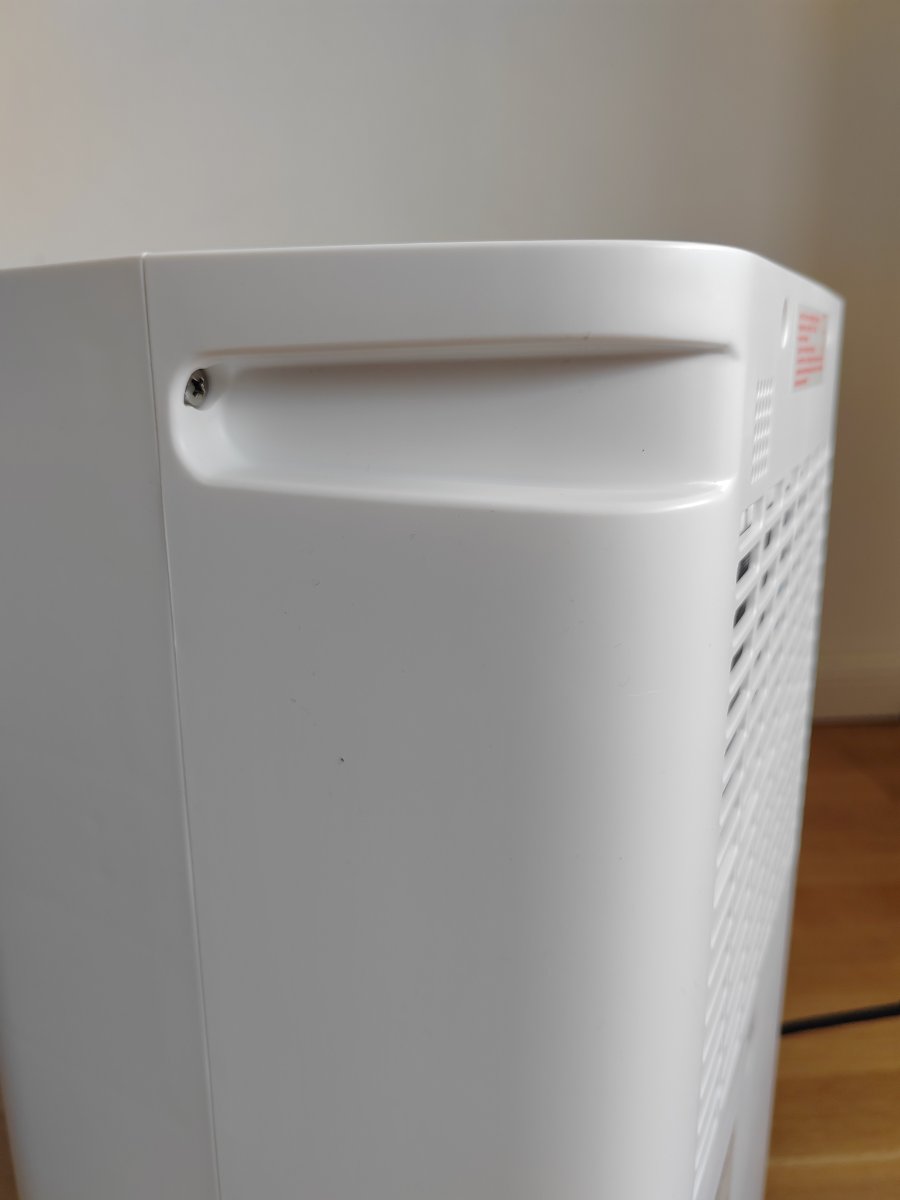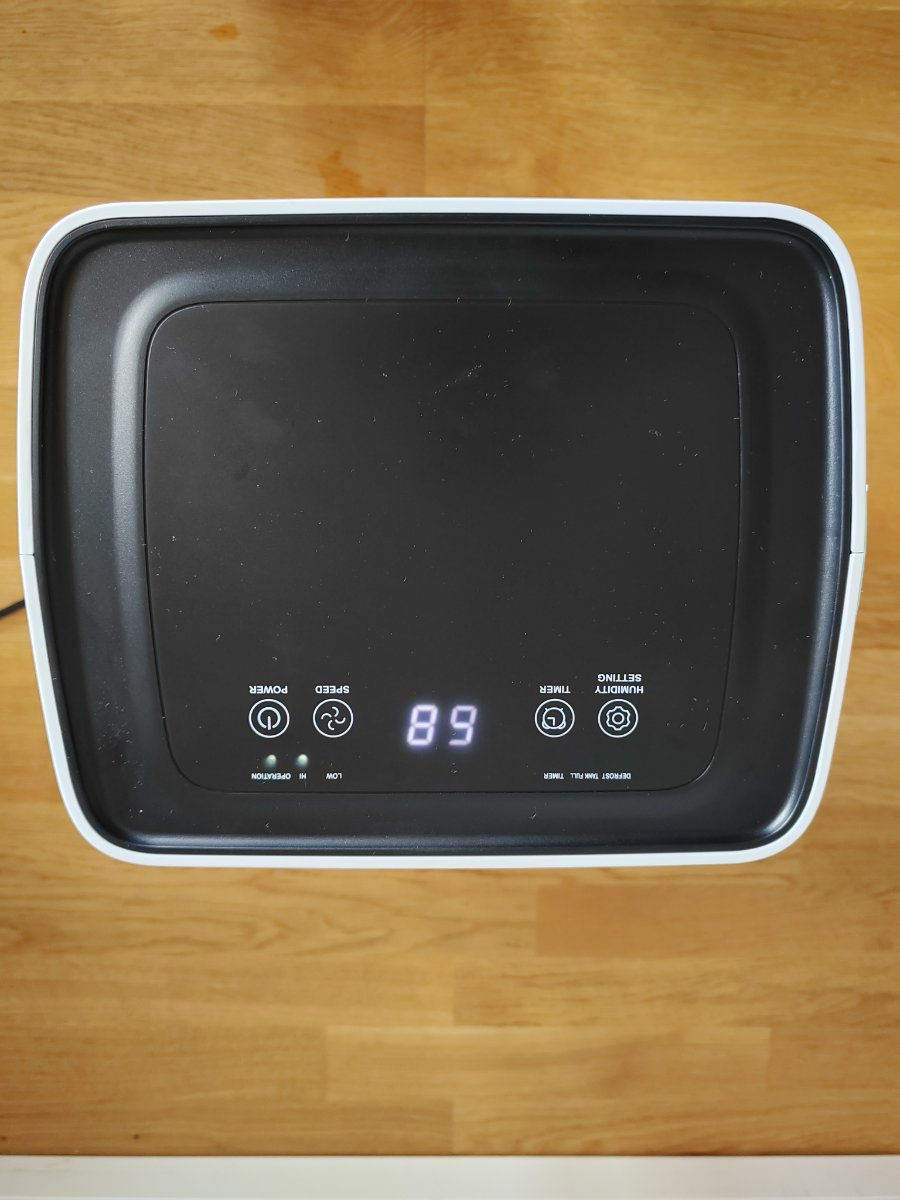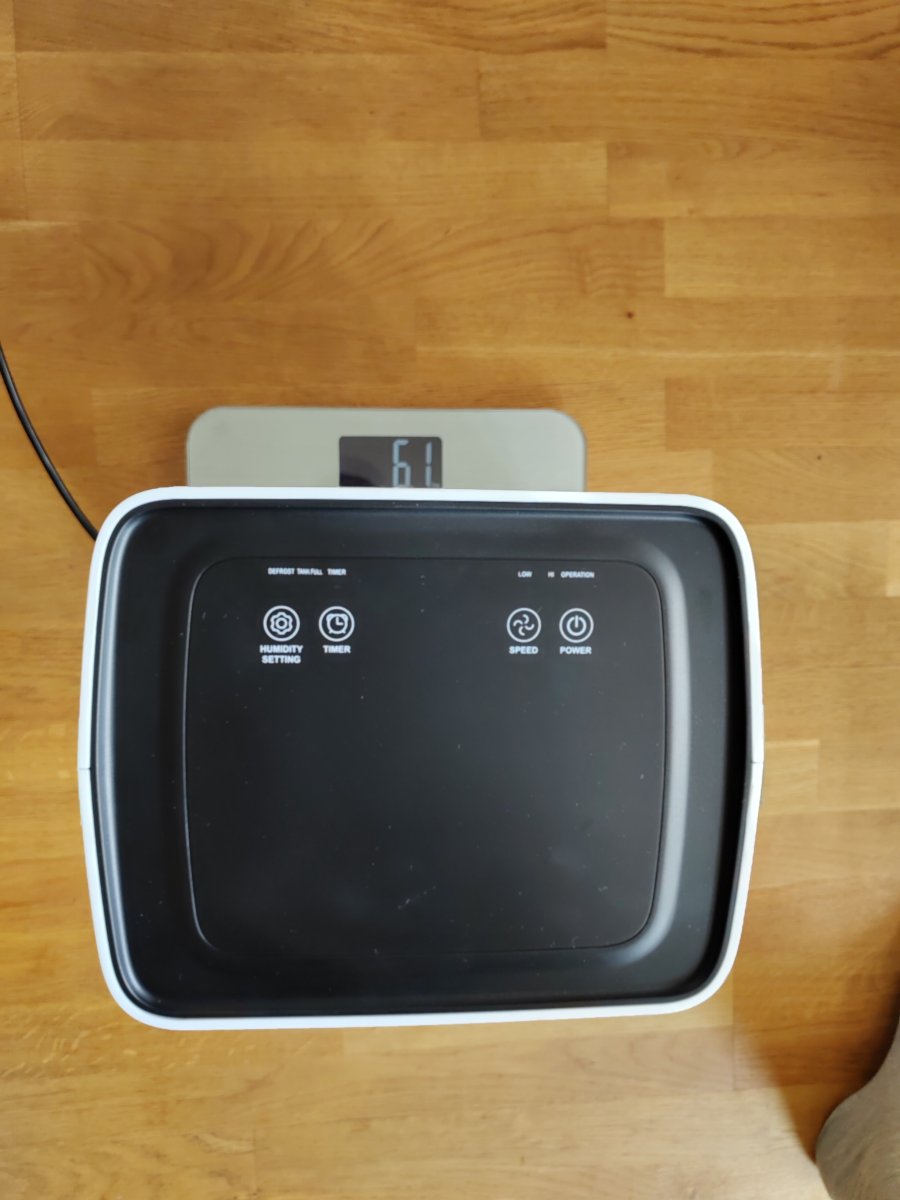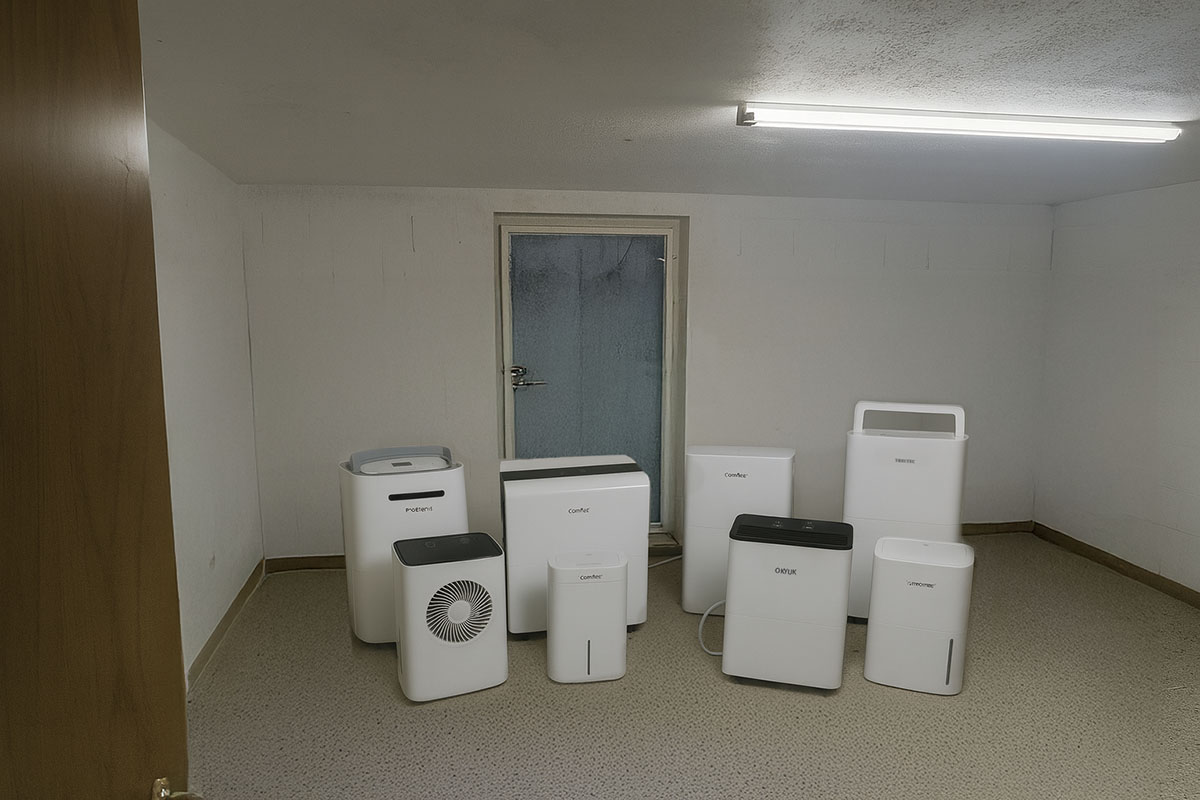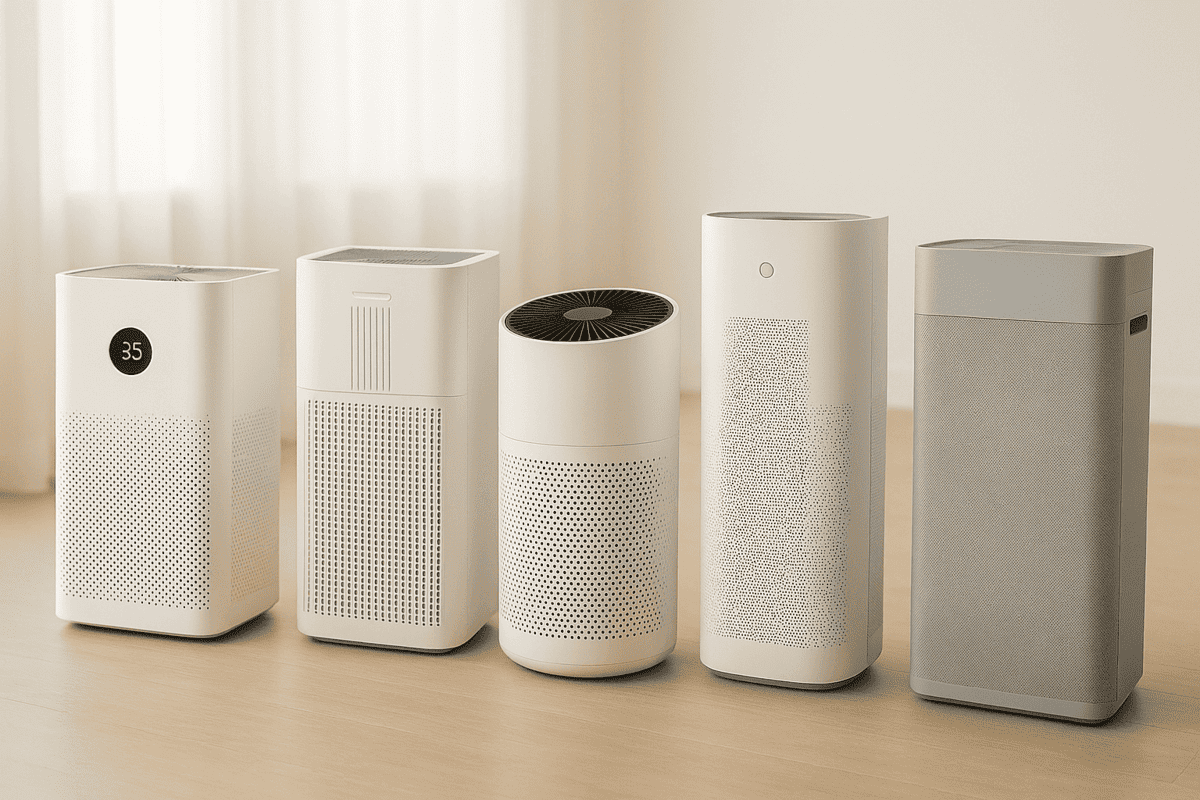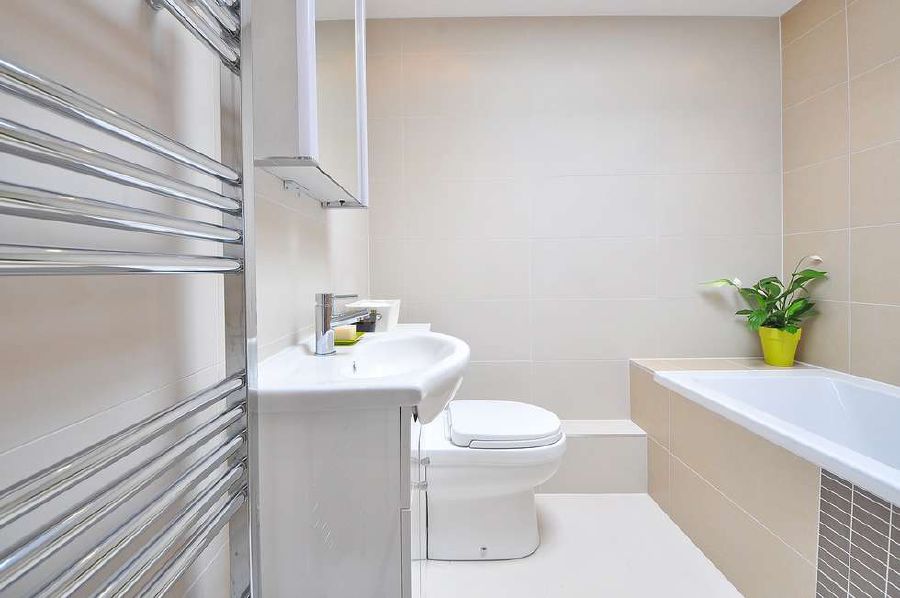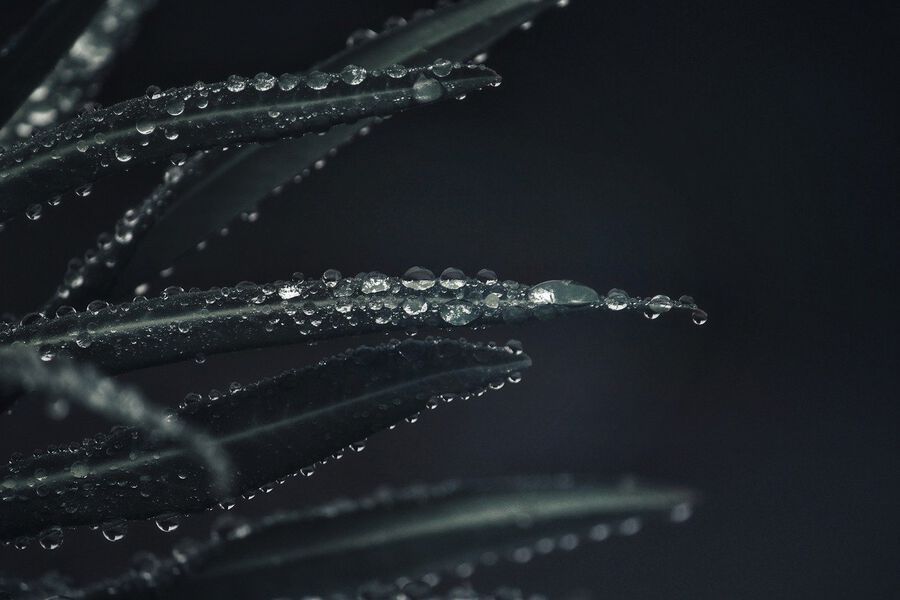Best Dehumidifier Test & Comparison 2025: Effectively Reduce Humidity at Home
Looking for the best dehumidifier to tackle damp rooms, mould or condensation? In this in-depth test and comparison, I’ve put popular models from brands like Comfee, Pro Breeze and Okyuk through real-life testing – not just lab conditions. Instead of artificial 30 °C and 80 % humidity setups, I measured performance in actual living spaces such as bathrooms, bedrooms and laundry rooms. Using precise instruments, I tracked noise levels, energy use and water extraction rates to see which models truly deliver in everyday situations. Whether you need a quiet dehumidifier for the bedroom, a powerful 30L unit for large rooms or a compact model for occasional use, this guide will help you choose the right one – complete with pros, cons and tips for efficient operation.
To my dehumidifier test & comparison:
In my test, the main results were Models with 10-30 litres per day used - including well-known manufacturers such as Comfee, Pro Breeze, Okyuk, Colaze and Newentor. I have also bought a super compact appliance from KANKA with 1.1 l/24 h to see how such mini models perform in everyday use. The following were tested real conditions in Living room, Bedroom and Bathroom - with different Temperatures and Humidities. With the Temtop LKC-1000S+ I measured the humidity and air quality precisely. Only in the direct comparison The strengths and weaknesses of the individual appliances and which dehumidifier is best suited for which area of application are revealed in this test. One of them clearly the test winner - You can find the details in the following report.
Under my test you will also find general information about humidity and the efficiency of dehumidifiers.
Best dehumidifiers compared and tested
It quickly became clear during the test: If you want to noticeably reduce the humidity, you should consider models from around 10 litres/24 hours. Even in small rooms - such as a bathroom with only 4 m² - mini appliances can barely keep up. After all, the actual purpose of a dehumidifier is to reliably reduce humidity and thus Prevent mould growth and create a pleasant indoor climate.
I measured all the appliances myself - volume in dB, temperature, humidity and how much water ends up in the container in a given time. This makes it immediately clear how well the individual models really work in practice - and not just on paper.Okyuk dehumidifier - Best dehumidifier 12 litres/24h – test winner
Advantages
❌ Disadvantages
According to my Endurance tests in different rooms and situations - from the small bathroom to the larger living room - I can now give you my absolute test winner introduce. No other model has been as convincing in everyday use as this one.
The biggest difference I noticed directly at the Volume on: During operation the device is Absolutely quiet compared to all other models. Only the Coaze achieved similar values in my test - all the others were much more audible. There are two modes (low and high) that hardly differ. I measured it myself: 36 dB in operation. In the video below you can compare the sound with other models - a real game changer, especially at night in the bedroom.
Also with the Processing the device stands out: high-quality materials, clean workmanship, compact design. Only the large Comfee 30 l/24 h comes along qualitatively, but feels four times the size and significantly heavier (almost 18kg).
What really impressed me was the Dehumidification performance under real conditions. With 25 °C and 60 % Humidity the appliance has completed around 210 ml water pulled out of the air. Even with 15 °C and 70 % Humidity performance remained almost identically strong - and this is exactly what distinguishes it from many competitor models, which noticeably collapse at cooler temperatures (relative to their general performance). The Humidity display is very reliable and deviates only by about ±4 % from my calibrated Temtop measuring device.
HintThe manufacturer's values (e.g. 12 l or 16 l/24 h) are produced under laboratory conditions at 30 °C and 80 % humidity - in practice, the values are usually significantly lower.In everyday life, the dehumidifier is Rollers very practical and easy to move from room to room. With only 7.6 kg it's handy anyway - even if I would like to have a Carrying handle would have liked, as the recessed grips on the sides are somewhat shallow.
The equipment covers everything important: Automatic operation, adjustable target values, continuous operation with hose connection, two power levels and a 2.5-litre water tankwhich is completely sufficient for everyday use.
In the field of application, the Test winner both in the 5 m² bathroom during and after showering, in the 16 m² bedroom and in the 25 m² living room. Only those who Basement rooms or areas from 40 m² would like to dehumidify, should Comfee 30 l/24 h the higher performance is worth it. For currently around 110-120 € but this test winner is a real insider tip and stands out as a clear recommendation even in comparison to more expensive models.
👉 Tip: Take a look at the video - you can hear the low and high levels in direct comparison - oh yes, it's already on and working when the video starts 😉 (measured 36-41 dB).
Comfee dehumidifier Best dehumidifier for large rooms: Comfee 30L/24h
Advantages
❌ Disadvantages
The Comfee 30 litre dehumidifier plays in a completely different league. With its enormous dehumidification performance, it is difficult to compare directly with the smaller 10-20 litre models - the focus here is clearly on Power for large rooms instead of compactness or bedroom use.
Performance in the test
In the practical test, the Comfee performed 25 °C and approx. 60 % humidity in about an hour 740 ml water withdrawn. Even with cooler 15 °C and approx. 70 % were still strong 695 ml - a value at which the smaller devices have long since reached their limits. Especially in Basements or large living spaces you will notice a significant improvement in the indoor climate after a short time.
Size & volume
The model is large - almost like a small block - and with almost 18 kg not a lightweight. Nevertheless, it remains mobile thanks to its castors. In terms of volume, it is around 50 - 55 dBsimilar to the Pro Breeze 20 l, but audibly louder than the other models, which were in the 36-42 dB range. Borderline for living rooms and bedrooms, but no problem for cellars or larger rooms.
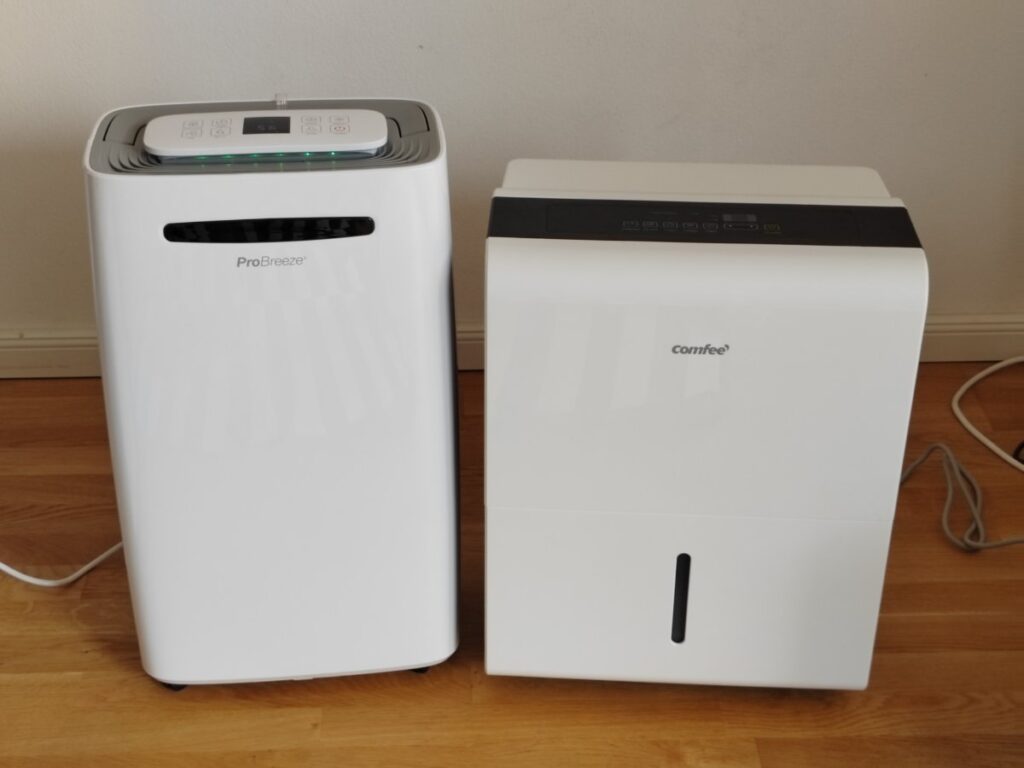
Operation & functions
The Display with hygrostat works very precisely and is only a few per cent off the calibrated measuring device in the test. For comparison: the Pro Breeze often showed around 10 % higher humidity the Comfee is clearly more reliable here. Operation is simple, with Automatic mode, continuous operation, timer and target value control. For long-term operation, the Drain hose be utilised.
Price-performance ratio
In terms of price, the Comfee is almost on a par with the Pro Breeze 20 l, but offers More power, more precise display and better features - a clear advantage for large areas.
ConclusionWho Cellars, large rooms or very damp areas If you want to dehumidify reliably, the Comfee 30 l is a real Powerhouse. It is larger and louder than the smaller models, but delivers a unbeatable performance for its price segment. If you need power, this is the place to go.
Pro Breeze 20l/24h - Balanced dehumidification with a focus on convenience and capacity
The Pro Breeze dehumidifier with 20 litres per day was a real positive surprise for me. What looks like a typical, white household dehumidifier at first glance turns out to be a Powerful and sophisticated helper against excessive humidity, mould and musty odours.
Compact and flexible in use
The device is Compact design and thanks to Castors and carrying handle can be used very flexibly in the home - whether in the bedroom, bathroom or, as in my test, the laundry room. Despite its rather small dimensions (25 × 39 × 66 cm), it draws moisture out of the air noticeably quickly. Even when Tumble drying it shortens the drying time - a real advantage in winter or in rainy weather.
Operation & functions
Operation is simple: set the target value, switch on, done. The LED display reliably displays the current humidity, and the Hygrostat adjusts automatically. Particularly practical is the Automatic switch-offwhen the great 5.5 litre water tank is full - or you can close a Drain hose and operates it in continuous operation, for example during construction work or in very humid rooms.
Power & volume
The measured values in the test were solid and were usually only 1 % off compared to separate hygrometers. the sensor is very accurate. In terms of volume, the Pro Breeze is around 50-55 dB and is therefore similarly loud as the Comfee 30 l/24 h. Perfect for cellars and larger rooms, but not for the bedroom at night.
Comparison with Comfee & other models
What I particularly like: Largest tank in the test - 5.5 litres - and therefore less frequent emptying than with most other appliances. It is also equipped with just under 12 kg It is easy to carry, which makes it more suitable for everyday use than the much heavier Comfee 30 litre. The workmanship and functions are solid, and you can't go wrong with this model in itself.
Nevertheless: In terms of price, it is almost on a par with the Comfee, which is Power simply delivers more. If I were to buy a device stationary use and maximum dehumidification, I would personally go for the Comfee. But if it's more about Mobility goes or you don't feel like constantly emptying the tankthe Pro Breeze is a good alternative.
OLAZE Dehumidifier 12L/24h -similar to Okyuk but with less power
Advantages
❌ Disadvantages
The Colaze dehumidifier is an exciting model - and not without reason. At first glance, it looks like the Okyuk test winner are not necessarily similar, but a closer look reveals that they are: Many components appear to be identical. The display, the control buttons, the 2.5 litre water tank and even the Permanent operation appear to have been taken over directly. The Volume is in a similar range, and the device is even a touch more manageable with slightly less weight.
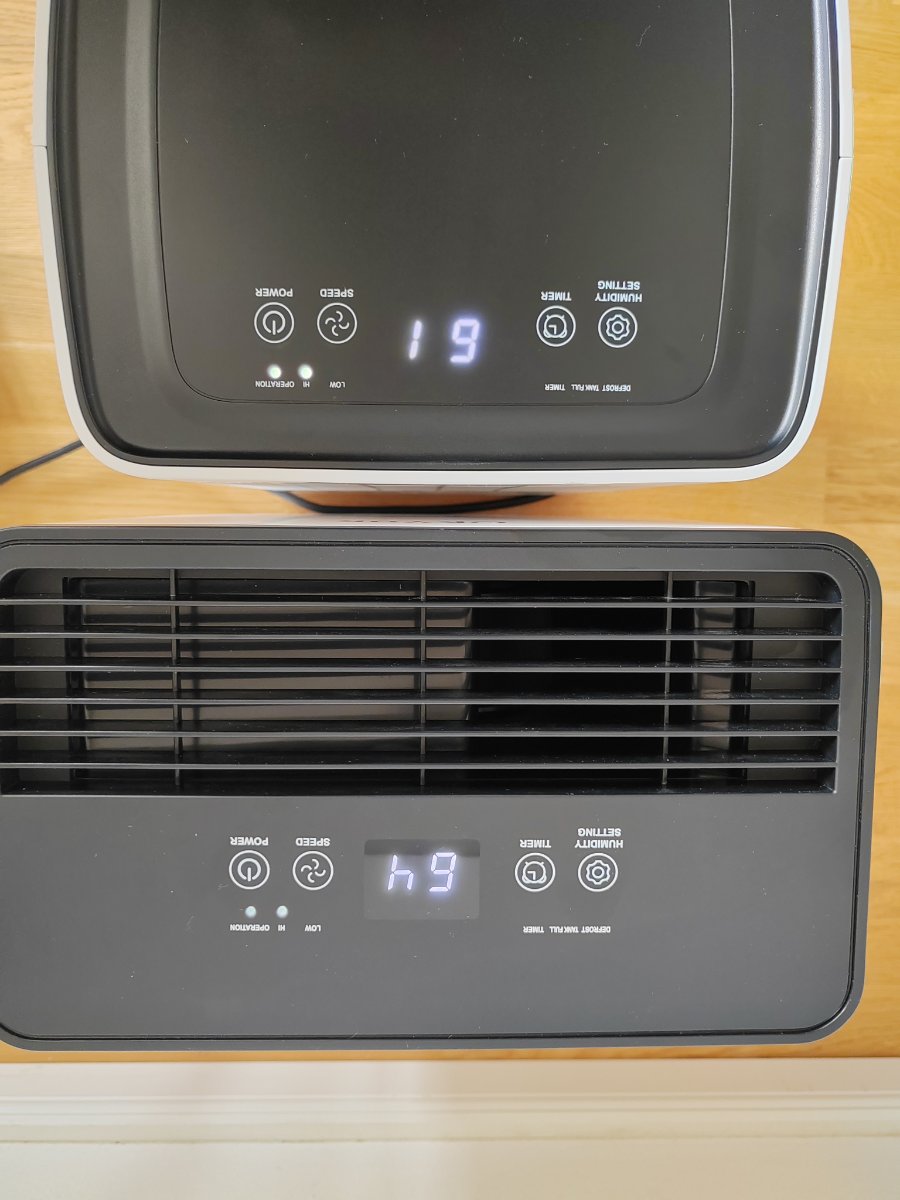
So why not a test winner?
The decisive point has been Practical test shown: the dehumidification performance. While the Okyuk is constant in my measurements 200-220 ml per hour the Colaze, under comparable conditions, was only about 90-100 ml per hour - so around 50 % less power. This is particularly noticeable in damp rooms and makes it less attractive for larger applications.
Conclusion
The Colaze is in itself a Solid device with all the important functions, simple operation and practical size. But: If you really want to dehumidify noticeably, the Okyuk simply offers twice as much performance for a similar price - and that's exactly why the Colaze doesn't land in first place for me. Small rooms with low humidity it can still be a favourable alternative.
Comfee dehumidifier 10L/24h, room size approx. 40m³(16m²)
Advantages
❌ Disadvantages
With a dehumidification capacity of up to 10 litres per day, the appliance is ideal for rooms up to around 16 m² (approx. 40 m³). This is also evident in practice: after just 30 to 45 minutes, a noticeable difference in the air quality was noticeable. I was able to significantly reduce the drying time of my hanging laundry, especially in the bathroom.
Operation is intuitive and simple - ideal if you just want a reliable appliance without a lot of bells and whistles. The LED display can be used to set target humidity values between 35 % and 85 %, as well as a timer and various modes. I personally find the reduced menu navigation very pleasant - less is sometimes more.
I was also pleasantly surprised by the mobility of the appliance: castors and a carrying handle make moving it around child's play. One clever detail is the frost protection mode, which switches on automatically and protects the appliance from damage caused by the cold - this was particularly important in an unheated cellar.
However, there are also some minor drawbacks. The operating noise is clearly audible, especially in very quiet rooms. It's not an unpleasant sound - more of a steady hiss - but I wouldn't leave it running in the bedroom at night. The water tank is also relatively small (2 litres), which means that it fills up quickly when the humidity is high and needs to be emptied more often.
Another detail: although there is an automatic switch-off when the target value is reached or the tank is full, there is no simple timer function for "run for x hours and then switch off". That would have been a practical feature.
Despite these minor criticisms, I am very satisfied with the Comfee dehumidifier. It delivers a strong performance, is solidly built and does exactly what it is supposed to do: reliably dehumidify the room air. If you are looking for a simple, effective appliance for typical living spaces, you definitely can't go wrong with this model.
KLAMER dehumidifier electric 20L - 180m³
Advantages
❌ Disadvantages
A big plus is the high air circulation rate of 180 m³/h, which is also reflected in the rapid effect. Rooms are pleasantly dry again within a short time. I was particularly impressed by how efficiently the dehumidifier works when drying laundry. The humidity drops and the laundry dries faster - without any unpleasantly stuffy room air.
The appliance is conveniently mobile. The four castors and practical handle make it easy to move. Despite its power, the KLAMER is comparatively quiet - ideal for daytime use in the living room. However, it is too loud for the bedroom, as many buyers confirm. It is therefore better to switch it off at night.
Operation is intuitive. I particularly like the three-colour LED display for the current humidity status (blue, green, red). The humidity display is also surprisingly precise - compared with an external hygrometer, the values were only around 5 % apart.
One small point of criticism is the position of the water tank: this is located at the back - including the fill level indicator. This makes it a little awkward to use in small rooms, as you may have to turn the appliance to see the water level or remove the tank. You should also make sure to switch off the appliance a few minutes before emptying it, otherwise water may run out.
All in all, the KLAMER dehumidifier is a real workhorse - reliable, cleverly designed and efficient. The workmanship is high quality and the price-performance ratio is absolutely right. If you can live with the rear tank removal, you will get an all-round successful appliance that does its job excellently.
Newentor 20L dehumidifier Electric basement 39dB
Advantages
❌ Disadvantages
The appliance not only works efficiently, but also extremely quietly. At just 39 dB in operation, it is even suitable for sensitive environments such as the bedroom or living room.
The indoor climate improved noticeably after just a few hours. I noticed a significant reduction, especially in the bathroom, where there is often a lot of moisture. The air in the cellar now also feels much fresher and more pleasant. The dehumidifier keeps the humidity constantly at a low level - ideal for mould prevention.
Operation is extremely simple: the touch display is clearly laid out, shows the current humidity and allows precise control of the target values. The 1.5 metre long drain hose supplied is a real convenience plus - so you don't have to keep emptying the tank. Those who still rely on the tank will find a sufficiently large volume and an automatic switch-off function when the tank is full.
The appliance has a modern, high-quality look. It blends unobtrusively into the room, takes up little space and can be moved quickly if necessary. Thanks to its compact construction and sophisticated design, it is suitable for rooms up to 50 m² or 150 m³.
In addition to the performance, the energy efficiency is definitely a highlight: even with regular use, I have not noticed any noticeable increase in my power consumption. The appliance works reliably, efficiently and without any annoying background noise. An all-round successful overall package.
I would also like to emphasise the 10-year guarantee - a strong sign of confidence from the manufacturer. For me, this is a clear plus point and an expression of quality and durability.
Bosch Dry 1000 dehumidifier
Advantages
❌ Disadvantages
The Bosch Dry 1000 (or Dry 2000) impressed me right from the start with its efficiency, quiet operation and user-friendly operation. I tested the appliance in various rooms - from the bathroom to the bedroom to the living room - and it reliably and effectively provided a noticeably drier indoor climate everywhere.
The dehumidification performance is strong: within just a few hours, water clearly collects in the 2.5 litre tank - a clear sign of how much moisture was actually present in the room air. The Bosch works quickly and thoroughly, especially in the bathroom or when drying laundry. The laundry dries faster and the room climate remains pleasant.
One of the biggest plus points for me is the Volume - or rather: the lack of it. The Bosch is barely audible in normal mode and even quieter in night mode. Even in the bedroom it does not disturb and can run overnight without any problems. Anyone who is sensitive to noise will love this dehumidifier.
The Operation works via an intuitive touch panel. In addition to automatic mode, a night mode and a special laundry mode are also available. In automatic mode, the appliance adapts to the current humidity level - this saves energy and reduces unnecessary running. The integrated hygrostat regulates precisely and reliably.
Also mobile the appliance cuts a fine figure: thanks to the smooth-running castors, it can be easily moved from room to room. The 2.5 litre tank is sufficient for several hours of operation, but the condensation water can also be drained directly via a hose if required - although the hose could be a little longer.
The Processing is - typically Bosch - high quality. The appliance looks stable, well thought-out and is visually unobtrusive and modern. For me, it is a clear recommendation if you are looking for an appliance that is uncomplicated, quiet and efficient.
Innvitop dehumidifier Electric 12L/24h with digital humidity display
Advantages
❌ Disadvantages
The Innvitop dehumidifier with 12 litres of dehumidification capacity per day has particularly impressed me in small to medium-sized rooms such as the bathroom or bedroom. Despite its compact size, it delivers an amazing performance and manages to dry humid air noticeably and quickly.
The digital humidity display on the appliance provides reliable information about the current room humidity at all times - a practical feature that you wouldn't necessarily expect in this price range. The target values are also easy to set, which makes everyday life much easier. The whole thing is complemented by a timer and a laundry drying function - particularly helpful in the more humid winter months.
The dehumidifier is Pleasantly quiet in operationThe fan is very quiet, sometimes barely audible - even at higher fan speeds, it remains discreetly in the background. This makes it interesting not only for bathrooms and kitchens, but also for living rooms and bedrooms. Although night mode is not explicitly named, it can also be used at night thanks to its low noise level.
Mobility is also a given thanks to the compact dimensions and castors. The water tank of around 1.6 litres is sufficient for the size of the appliance, but can fill up quickly in high humidity. If you need longer running times, simply use the drain hose supplied - a welcome option.
The only point of criticism: The workmanship of the tank seems a little fragile on some models, and there have been a few reports of a grazing fan noise. However, this was not the case with my device - it runs evenly, quietly and reliably.
The bottom line is that with the Innvitop you get a very well-balanced overall package: quiet, compact, with good performance and ideal for smaller rooms - and at a really fair price.
General information on dehumidifiers and humidity
Humidity is an important value for the indoor climate. It indicates how much water is contained in the air. If there is too much water in the air, this can lead to mould. Too little humidity, on the other hand, can irritate the mucous membranes.
It is always advisable to keep an eye on the humidity level. Corresponding sensors cost no more than an ordinary thermometer.
Multifunctional measuring devices that display humidity and temperature at the same time are recommended. They are priced between €10-20.Relative and absolute humidity
So that no misunderstandings arise in the further course of the article: There is the absolute humidity on the one hand, and the relative on the other hand.
With the absolute is the amount of air (usually in grams)that is contained in a certain amount of air (usually one cubic metre). Assuming that a room contains 5 grams of water in every cubic metres of air. Then the absolute Humidity 5g/m³.
The relative humidity indicates the extent to which the air is saturated with water. That sounds more complicated than it is. Here is the explanation:
Warm air can absorb more water than cold air. If the air is 10°C warm, it can absorb a maximum of approx. 9.5 grams of water per m². If it is 20° warm, it is approx. 17.5 grams [ 1 ] .
If we have a cubic metre of air that is 10°C warm and contains 9.5 grams of water, then the relative humidity is 100%. More water is therefore not possible. If it contains only 5.25 grams of water, the relative humidity is 50%.

In short: The relative humidity indicates the percentage of water saturation in the air.
When is a dehumidifier really useful?
A dehumidifier is useful if you want to Reduce excessive humidity want - for example to prevent mould or in the event of poor ventilation. It is particularly worth using in the following cases:
- ✅ In humid conditions Cellar roomsespecially in summer
- ✅ After Water damage such as burst pipes or flooding
- ✅ In New buildings or renovated flats with a lot of building moisture
- ✅ In Living spaces with risk of mould (e.g. interior bathrooms)
- ✅ At the Drying laundry in the flatto dissipate moisture more quickly
A dehumidifier does not always make sense - especially if the causes of excessive humidity have not been remedied or the room is already sufficiently dry:
- ❌ With Continuous operation without analysing the cause (e.g. building defects, incorrect ventilation)
- ❌ In rooms that are too dry - below 40 % Humidity is detrimental to well-being
- ❌ In cold rooms below 15 °Cwhere condensing units operate inefficiently
- ❌ If through Tilted windows or open doors New moisture is constantly flowing in
- ❌ As Permanent solution without a solution - Better to check the building fabric or ventilation
Is a dehumidifier an electricity guzzler?
A typical dehumidifier consumes the following during operation between 200 and 700 watts. Depending on the model, room size, humidity and running time, this can lead to lead to significant electricity costs - especially with continuous operation or inefficient use.
What does the power consumption depend on?:
- Power consumption (watts): Higher power = more consumption, but possibly shorter running time
- Running time per day/week: Continuous operation without demand drives up costs
- Setting & target value: The lower the desired humidity, the more the appliance has to do
- Room temperature: Many appliances work less efficiently in cold rooms
- Appliance type & efficiency class: Older models without automatic switch-off or hygrostat consume more
This turns your dehumidifier into an electricity guzzler:
- When he permanently runningalthough the problem could be solved structurally or by ventilation
- When he undersized and never reaches the desired humidity
- When Windows or doors open and new moisture is constantly flowing in
- When Incorrect device types (e.g. condensing units in cold cellars) can be used
💡 Calculate the electricity costs of your dehumidifier:
🔌 per hour: 0.00 €
📅 per day: 0.00 €
🗓 per month: 0.00 €
📈 per year: 0.00 €
How long should a dehumidifier run per day?
This depends on the room size, humidity and appliance output. As a rule 2-6 hours per day if the appliance is strong enough and is used selectively (e.g. after showering, drying laundry or in high humidity above 60 %).
An integrated Hygrostat ensures that the dehumidifier switches off automatically as soon as the target value is reached - thus avoiding unnecessary continuous operation and electricity costs.
Practical examples
The daily running time depends on room size, humidity and appliance performance. Many models manage around 20 litres in 24 hours. Two typical examples:
Example 1: Bedroom, 12 m²
- Initial humidity: 70 %, target: 55 %
- Appliance: 200 W, approx. 0.8 litres/h → 20 litres in 24 h
- Running time: approx. 3-4 hours daily
- Tip: Hygrostat regulates automatically when target value is reached
Example 2: Damp cellar, 25 m²
- Initial humidity: 75 %, target: 60 %
- Appliance: 450 W, approx. 1.5 litres/h → 36 litres in 24 h
- Running time: approx. 5-7 hours a day (more at the beginning)
- Tip: Keep doors closed, supplement shock ventilation
Rule of thumb: The higher the humidity and the weaker the appliance, the longer it will operate. A hygrometer helps with monitoring.
Use of a dehumidifier
The appliance is used in rooms in which the humidity is to be reduced. The dehumidifier requires several hours or days to do this (depending on its own capacity, the size of the room and the water content of the air).
In private rooms, these devices are often used to Room with poor ventilation to dehumidify. Primarily when moisture peaks occur. This happens, for example, when bathing, showering, cooking, drying laundry or exercising.
Larger models are used on construction sites or for dehumidification after water damage. They have a correspondingly higher output and noise level, which is why they are less suitable for private users.
Types and function
There are different technologies that can be used to extract water from the air. Some require a power supply, others do not. The latter require a special filter or granulate. However, the filter or granulate must be replaced at regular intervals.
Dehumidifier with Peltier element
A Peltier element is a very exciting component: if current flows through it, it generates a temperature difference. Conversely, a temperature difference at the element can generate a current flow.
The Peltier element is used for cooling.As mentioned in the section on relative humidity, cold air can hold less moisture than warm air. If the air is cooled by the Peltier element, condensation will form. You can observe the same thing if water condenses on the window panes when cooking or after showering.
The disadvantage of the Peltier element is its lower efficiency (compared to compressor technology). On the other hand, dehumidifiers with a Peltier element are much quieter. They are therefore particularly recommended for use in private rooms.
Dehumidifier with compressor
Dehumidifiers with compressors also cool the air. Only the method of cooling is different. In principle, the cooling method is comparable to that of a refrigerator. A compressor is also installed in a refrigerator. Sometimes you can even hear it humming.
Let's take a look at how cooling works using a compressor. It will be a little technical, but there is a practical summary at the end. Here we go:

In addition to the compressor, the refrigerant is the key component of the cooling system. Just like water, the refrigerant can be gaseous, solid or liquid.
Water freezes from 0°C, evaporates from 100°C and is liquid in between. The refrigerant, on the other hand, evaporates at room temperature.
When a liquid is vaporised, regardless of whether it is water or a refrigerant, it absorbs heat energy. You also have to place a saucepan of water on a hot hob for the water to evaporate.
Conversely, as soon as the vapour becomes liquid again - i.e. condenses - it releases this energy again. And there we have the whole principle:
If we vaporise the refrigerant at one point, it absorbs heat energy from there. We then channel the refrigerant to another point and allow it to condense there. The absorbed heat energy is then released again.So we have transported the heat from one place to another. The place from which we have taken the heat has become colder. Logical, isn't it?
Vaporising the refrigerant is simple. As I said, it already vaporises at room temperature. After the refrigerant has been channelled to another location, it should condense. But how do we do that? Would we have to cool it again?
This is where the compressor comes into play. It compresses the vapour, i.e. increases the pressure. And if the refrigerant is under high pressure, the temperature at which it condenses drops.
Summary of the mode of operation
The dehumidifier with compressor cools the air, which causes the water vapour from the air to condense on the cold cooling device.
A refrigerant is used for cooling, which absorbs heat energy during evaporation and releases it again during condensation. Consequently, the place where the heat energy is absorbed is cooled.
Advantages and disadvantages
Dehumidifiers that work with a compressor are more efficient than models with a Peltier element. They can extract more moisture from the air. Larger models are used for drying on construction sites, for example, and can remove several litres per hour from the air.
The disadvantage is the volume. The appliance emits a humming noise similar to that of a running refrigerator.
Dehumidifier with granulate
Models with granulate collect the moisture in the granulate. The porous and very dry granulate absorbs the water from the air and does not require a fan.
The clear advantage of dehumidifiers that rely on granulate is that they Not tied to a power socket are. However, the granulate can only absorb a certain amount of water before it needs to be replaced.
In terms of price, dehumidifiers with Granules relatively favourable. As no electronics are installed, the price is correspondingly lower. The granules themselves don't cost much either. Depending on the manufacturer, you can get several kilograms for around €10.
This type of dehumidifier is recommended where high humidity only needs to be combated sporadically. If high humidity occurs regularly, then a model with a Peltier element or compressor is more appropriate.
Additional functions
The appliances differ in their dehumidification technology and in the additional functions that simplify their use.
Automatic switch-off
In my opinion, the most necessary additional function is the automatic switch-off. This is because the collected water usually ends up in a container in the appliance. If this is full, the appliance should be able to recognise this and switch itself off.
Larger models are sometimes equipped with a Drain hose equipped. They eliminate the worry of an overflowing water tank. However, they also require some kind of automatic switch-off function:
Dehumidifiers that work with a cooling system must prevent the water from icing up on the heat sink. If the water freezes there, the dehumidifier can no longer work properly. Therefore, either the temperature must be carefully regulated by the appliance or it switches off the cooling at regular intervals to defrost.
Timer
A timer, or a Integrated timer are definitely useful. All you have to do is switch the appliance on and set a time frame. The dehumidifier then switches itself off after the set time.
This can help with short-term peaks in humidity, especially in private households. For example, it could help to switch the appliance on for a certain amount of time after showering. A dehumidifier can also be helpful when drying laundry.
Air filter
As many dehumidifiers have a fan, it makes perfect sense to install an air filter. Appliances with such an air filter dehumidify and purify the air at the same time.
Depending on the filter, various substances such as pollen or Dust filtered out of the room air become.
Humidity display
As mentioned at the beginning; it is essential to keep an eye on the humidity reading. Only then can you use a dehumidifier in a targeted manner. If a corresponding display is installed on the appliance, this will of course help.
Sensor control
Modern models not only measure the humidity, but also react independently on it. If they measure an increased value, they switch on automatically. This function is practical in the kitchen or bathroom, for example. Moisture peaks occur there several times a day, which a dehumidifier with sensor control automatically counteracts.
Purchase criteria for dehumidifiers
After we have looked at the functionality and the possible extras, we derive the most important purchase criteria. Here they are in a nutshell:
- Capacity (litres per hour)
- Size of the collection container
- Energy consumption
- Volume
- Additional functions
- Dimensions
- Design
- Price
Performance
How much water the appliance can collect in a certain time is the most important value for me. After all, I don't want it to run all day, but to make progress in as short a time as possible.
Capacity
So that the Container If the container needs to be emptied, it should be large enough. Specifically, it should be able to hold at least 500ml.
Volume
The noise level is particularly important for models that are to be operated in private rooms. A constant humming noise is distracting when working, relaxing - and especially when sleeping. Therefore, check the manufacturer's volume specifications before buying. Recommended values are around 40 dB for living spaces.
It only gets really quiet below 30 dB - which is roughly equivalent to whispering or a quiet bedroom. However, such low values are achieved Only very few devices and mostly only in the Eco or night mode. Those who value maximum peace and quiet should look specifically for ultra-quiet models with Peltier technology or special silent compressors, for example.
Additional functions
About which Additional functions The features of the dehumidifier can be a decisive factor in the purchase decision. As already mentioned, displays showing the current temperature and humidity are practical. A timer or sensor control is even better. With the Timer you can specify how long the device should run. One Sensor control measures the humidity itself and switches the dehumidifier on and off automatically.
Design
The often box-shaped devices are rarely a real feast for the eyes. Therefore, as far as looks are concerned, I recommend as monochrome as possibleinconspicuous housings. White or light grey are ideal here. Flashing displays, convoluted designs or a clunky stand contribute to an unsettling overall impression.
It is better to have a box that is as even as possible, in one colour and can stand flush on the floor and against the wall. If you can also hide unnecessary cable lengths in the appliance, all the better.
Price
Electric dehumidifiers are priced at 50-150€. Models that work with granules are available from around €10.
The price depends on the dehumidification performance as well as the additional functions and the design. We have already looked at the additional functions a dehumidifier can have.
Whether and to what extent the extras justify a surcharge depends on your application. In principle, I wouldn't want to spend more than €200 on a device for a private household. The Lower limit is in my eyes about 40-50€.
Rent a dehumidifier
It is not always necessary to buy a dehumidifier. The purchase costs are relatively high, especially for larger appliances such as construction dryers. However, if the construction dryer is only to be used for a short time, then it is worth hiring it.
My first port of call would be the nearest DIY store choose. It's always a good idea to call first. This may save you a journey or two.
If there is no DIY store in your area that rents out dehumidifiers, you may be able to find one at the Internet. With a bit of luck, you may even find corresponding offers on eBay Classifieds. Advertisements there often have a fair price and contact with the provider is uncomplicated via chat or telephone.
FAQs on dehumidifiers
A dehumidifier removes excess moisture from the room air by drawing in the air and passing it over a cooled surface, causing the water vapour to condense and be collected in a container. The dried air is then released back into the room.
The suitability of a dehumidifier depends on its capacity, which is measured in litres per day. Smaller models are suitable for rooms up to around 20 m², while more powerful appliances can also work efficiently in larger rooms of up to 50 m² or more. Pay attention to the manufacturer's specifications for the maximum room size.
The efficiency of a dehumidifier depends on the room temperature, humidity and the capacity of the appliance. Most appliances work optimally at a room temperature of 20-30 °C. At lower temperatures, efficiency decreases as the air contains less moisture.
Power consumption varies depending on the model and running time. Typical appliances consume between 200 and 600 watts per hour. To minimise energy consumption, it is advisable to only run the dehumidifier until the desired humidity level is reached.
How often the water tank needs to be emptied depends on the room humidity, the capacity of the dehumidifier and the size of the collection tank. As a rule, the container must be emptied every 1-3 days. Some models also offer the option of continuous water drainage so that emptying is not necessary.
Yes, a dehumidifier can reduce the risk of mould growth by lowering the humidity to a healthy level. Mould thrives in humid environments, so a dehumidifier helps to keep the indoor climate dry and therefore mould-free.
A dehumidifier can be useful all year round, especially in humid summer months or in poorly ventilated rooms in winter. During the heating season, it can help to keep the indoor climate comfortable and prevent excessive moisture that could lead to condensation on windows or mould.
Conclusion
Keeping an eye on the indoor climate is always a good thing. If you notice increased humidity, the first thing to do is to Correct ventilation.
But in some rooms this is not always so easy. Be it because there are no windows, No proper draught or simply arises too frequently and too Many moisture peaks (e.g. in the bathroom or kitchen).
To speed up the air exchange, an air filter can be installed in living and working areas. Ceiling fan help. If there are air ducts in the bathroom or kitchen, the typical Bathroom fan can be used to help.
If these options have been exhausted and the desired effect has still not been achieved, a dehumidifier can help. Although it often consumes more energy than fans, it removes moisture effectively.
The opposite of a dehumidifier
If you want to increase the humidity rather than reduce it, there is also a suitable appliance class for this:

Diffuser
Recommended diffusers and how you can use them to improve the indoor climate.
Diffusers vaporise liquid and thus increase the humidity. They can also be filled with fragrances and essential oils, which they then distribute over several hours.
Sources
[1] ↑ https://de.wikipedia.org/wiki/Luftfeuchtigkeit






























